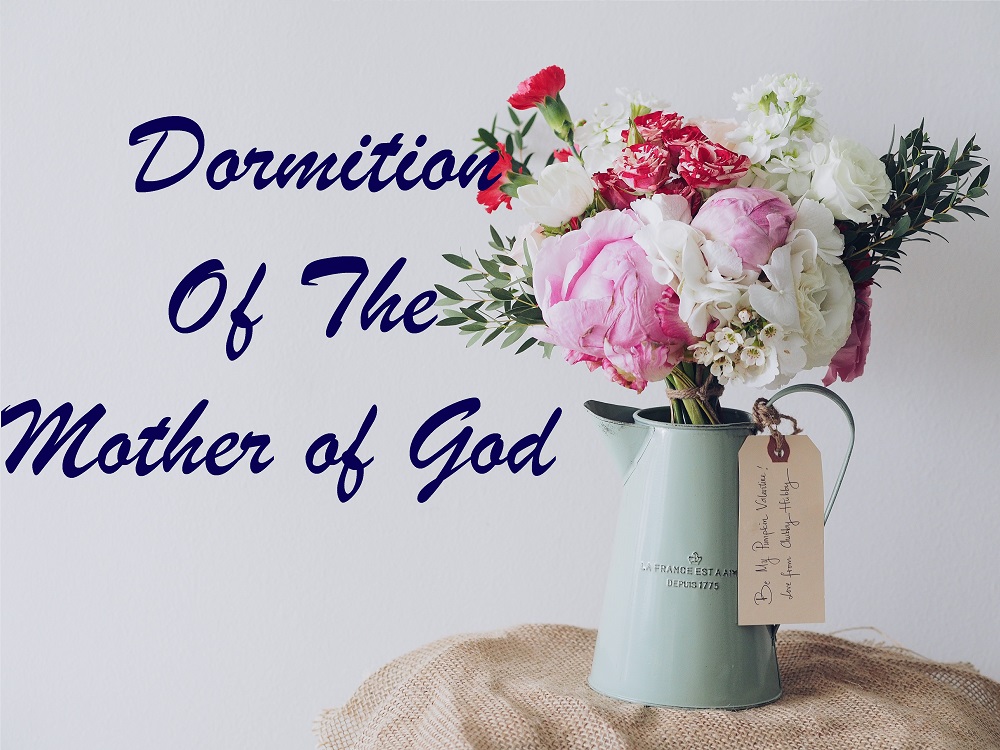This document was adapted from responses gathered in breakout sessions at the 38th UCWLC Eparchial Convention Edmonton Branch Cultural Session, Oct. 2017
At the time of her death, the disciples of Our Lord who were preaching throughout the world returned to Jerusalem to see the Theotokos. Except for the Apostle Thomas, all of them including the Apostle Paul were gathered together at her bedside. At the moment of her death, Jesus Christ himself descended and carried her soul into heaven.
Following her repose, the body of the Theotokos was taken in procession and laid in a tomb near the Garden of Gethsemane. When the Apostle Thomas arrived three days after her repose and desired to see her body, the tomb was found to be empty.
The bodily assumption of the Theotokos was confirmed by the message of an angel and by her appearance to the Apostles. The Dormition of the Theotokos is a confirmation of the resurrection of Christ and a source of hope for the faithful in the promise of their personal resurrection, their personal Pascha. The death of the Theotokos and her translation into heaven confirms the divine promise of Christ to His faithful children that they will enjoy life eternal in everlasting communion with God.
According to an old custom, flowers and medicinal herbs are blessed after the Divine Liturgy on the Feast of the Dormition. According to traditional belief, after Mary’s assumption, her tomb was filled with a “heavenly fragrance” and flowers. The herbs, used as natural medicine, are blessed in commemoration of the numerous healing and extraordinary graces bestowed on the pilgrims at Mary’s tomb.
- Place an icon of the Dormition in the icon corner. Decorate the corner with flowers.
- Process with flowers to the icon corner or have the children bring flowers from home.
- Say a prayer of blessing and put it in their prayer corners.
- Explain the meaning of the feast of the Dormition and then have the children colour an icon.
- Learn to sing the Tropar and Kondak of the feast or learn a new hymn to Mary.
- Take flowers to church to be blessed by the priest.
Group Response for Feast Day
Discuss which of these traditions are practiced in your family/church, that is, traditions which have bridged you to the generation before you.
- Blessing of flowers after Liturgy.
How can you build a bridge of these traditions to the next generation…. in your family? in your church?
- For those who aren’t in church, bring the blessed flowers to them and give them a brief explanation.
- Those who are in church, get family members to bring the flowers. Find a way to remind them.
- Have a short explanation in the bulletin by the priest or the ladies’ league.
- Perhaps do a craft at a ladies’ meeting (making scented oils) or with the children (making flower wreaths).
- Have an explanation of the icon. Children colour a picture of the icon.
- Have family participation at church so it becomes a family tradition. Teaching and
explanations of the traditions at home.
- Celebrate the feast day on the Sunday before or after, so families can participate.
Discuss ways that you can enhance the traditions, that is, make them more meaningful …in your family ….in your church.
- Children make paper flowers and bring up as families.
- Children plant flowers in the spring at church and then cut them for the feast day.
- Hand out flowers as people come into church. Give one to each person and have them walk to the front and place their flower at the icon of Mary to symbolize the flowers and the aromatic scent that came from Mary’s tomb when it was opened. Then each person takes a flower home and places it at their Mary icon or photocopy of an icon that has been colored.
- Actually, families can purchase a complete set of icons to have at home. They can purchase a simple inexpensive frame and change the icon as a new feast day approaches.

